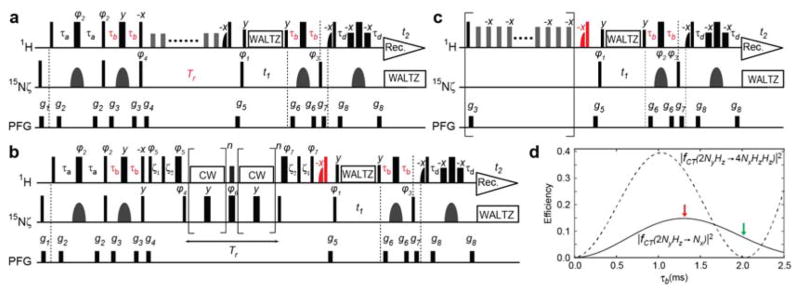Figure 1.
Pulse sequences for the 15N relaxation measurement on lysine side-chain NH3+ groups. The key elements in the current work are indicated in red. Thin and bold bars in black represent hard rectangular 90° and 180° pulses, respectively. Water-selective half-Gaussian (2.1 ms) and soft-rectangular (1.2 ms) 90° pulses are represented by half-bell and short-bold shapes, respectively. Unless indicated otherwise, pulse phases are along x, and the carrier position for 1H was set to the position of the water resonance. The 15N carrier position was set to 33.1 ppm. A gray bell-shape for 15N represents an r-SNOB[36] 180° pulse (1.0 ms) selective to Lys side-chain 15Nζ nuclei. The delays τa and τb were 2.7 ms and 1.3 ms, respectively. Quadrature detection in the t1 domain was achieved using States-TPPI, incrementing the phase φ1. Pulsed field gradients (PFGs) were optimized to minimize the water signal. (a) 15N R1 measurement. Although it is not essential owing to negligible CSA-DD cross correlation for NH3+, a 1H 180° pulse, which does not affect H2O resonance, was applied every 10 ms during the delay Tr for longitudinal relaxation. Phase cycles: φ1 = (2y, 2(−y)), φ2 = (y, −y), φ3 = (4x, 4(−x)), φ4 = (8y, 8(−y)), and receiver = (x, −x, −x, x, 2(−x, x, x, −x), x, −x, −x, x); (b) 15N R2,ini measurement. The RF strength for 15N pulses for the CPMG scheme was 5.4 kHz. The 1H carrier position was shifted to 7.8 ppm right after the PFG g4 and set back to the position of water resonance right after the PFG g5. The RF strength ωCW/2π of 1H CW during the CPMG was set to 4.3 kHz, which was adjusted to satisfy ωCW/2π = 2kνCPMG (k, integer) [37]. The delays ξ1 and ξ2 are for alignment of 1H magnetization and given by ξ1 = 1/ωCW − (4/π)τ90H and ξ2 = τ90N − (2/π)τ90H [37,38], in which τ90 represents a length of a relevant 90° pulse. Phase cycles: φ1 = (4y, 4(−y)), φ2 = (8y, 8(−y)), φ3 = x, φ4 = (x, −x), φ5 = (2y, 2(−y)), φ6 = (2x, 2(−x)), φ7 = (2(−y), 2y), and receiver = (x, −x, x, −x, 2(−x, x, −x, x), x, −x, x, −x); (c) Heteronuclear 1H-15N NOE measurement. Measurement with 1H saturation (5 s) was performed with a train of 180°x and 180°(−x) pulses (RF strength, 11 kHz) at an interval of 10 ms. The 1H carrier position was at 7.8 ppm during the 1H saturation period. The reference spectrum was measured without the scheme in the bracket. The recycle delay (including the saturation period) was set to 18 s for a 750-MHz spectrometer. Phase cycles: φ1 = (y, −y), φ2 = (4x, 4y, 4(−x), 4(−y)), φ3 = (2x, 2(−x)), and receiver = (x, −x, −x, x, −x, x, x, −x); (d) Efficiency in coherence transfers as a function of the delay τb calculated using Equations (2) and (3) with |1JNH| = 74 Hz and 1H 180° pulse length of 20 μs. The results for the Ny and 4NyHzHz terms are shown in solid and dotted lines, respectively. Red and green arrows indicate the values of the delay τb in the current and previous pulse sequences, respectively.

